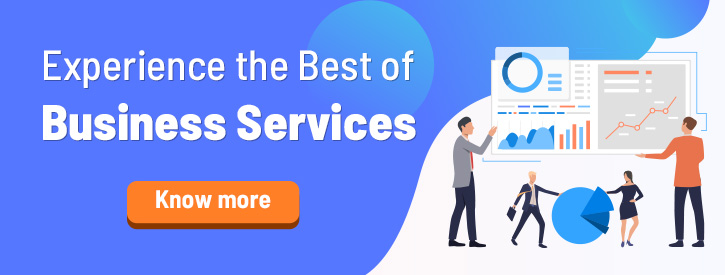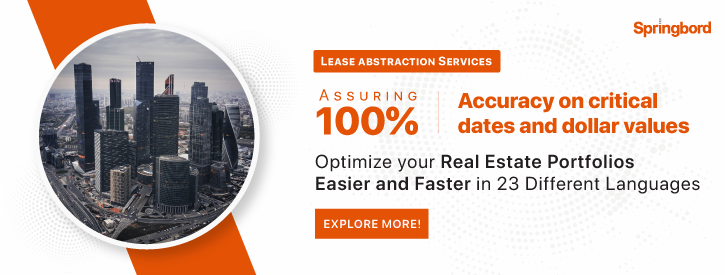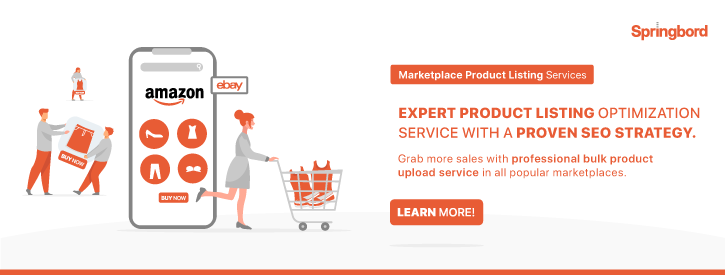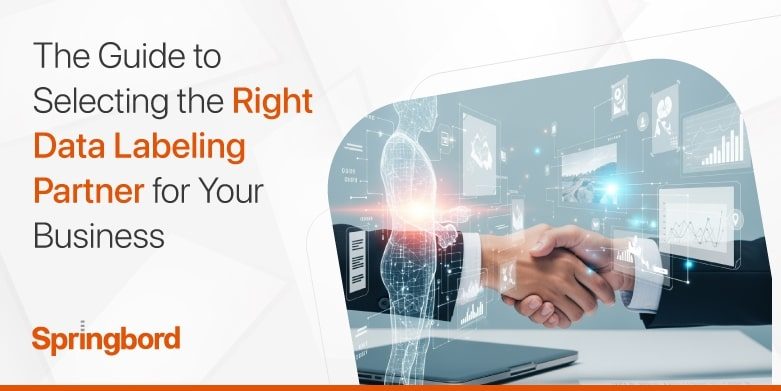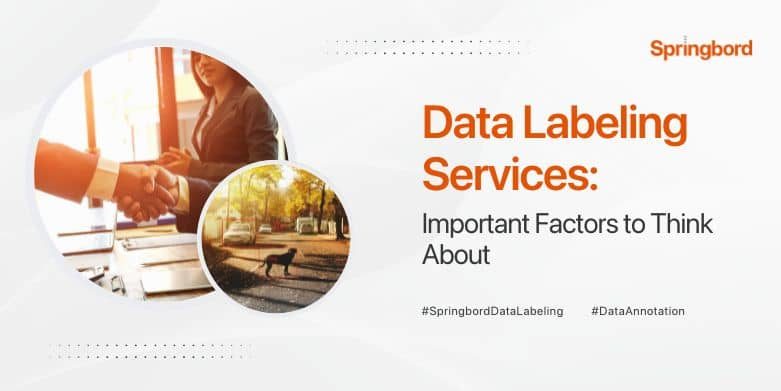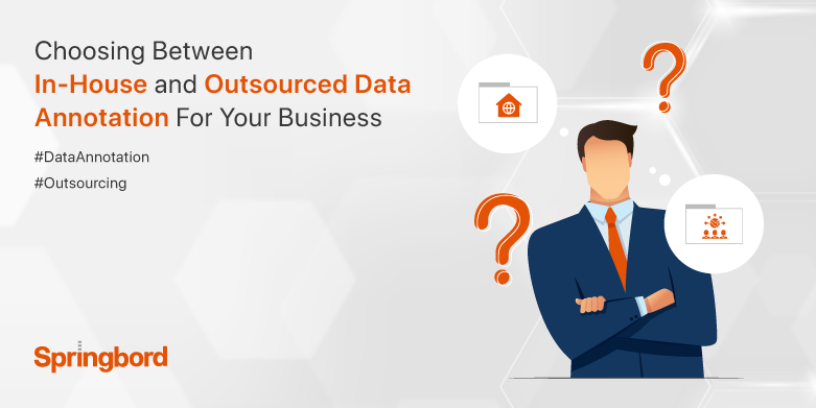 Read time 7 min
Read time 7 minChoosing between in-house and outsourced data annotation is a critical decision that directly impacts the efficiency, scalability, and success of your AI initiatives. The core mechanism that powers machine learning is annotation, which is not a background process. Even the best algorithms will not produce useful results if the data is not properly labeled. As AI models require massive volumes of structured training data, the need for efficient and high-quality annotation becomes a strategic priority, not a technical afterthought.
According to Cognilytica, 80% of AI project time is spent on data preparation and engineering, including annotation, often making it the most resource-intensive stage of the AI lifecycle. With these realities in mind, businesses face a crucial operational question: Should data annotation be managed internally for greater control or outsourced to experts for speed and scale?
In this blog, we explore the pros and cons of each approach, highlighting real-world trade-offs in control, cost, quality, and compliance. It is imperative to comprehend your annotation strategy to optimize project agility and ROI, regardless of whether you are implementing AI in real estate, e-commerce, or enterprise automation.
Springbord provides domain-specific expertise, scalable infrastructure, and flexible delivery models to assist you in making the appropriate decision, allowing you to concentrate on innovation while we manage the foundation.
In-House Data Annotation – Control at a Cost

For businesses working with sensitive data or industry-specific models, keeping data annotation in-house may seem like the safer, more controlled path. It offers direct supervision and tighter alignment with internal teams. However, that control comes with a price, both in terms of cost and operational efficiency. Here’s how it breaks down:
Pros
Managing data annotation internally gives businesses direct oversight and greater control over sensitive datasets. For companies dealing with proprietary data or strict compliance standards (such as in finance or healthcare), this control translates into stronger IP protection, better data privacy management, and alignment with internal teams, particularly product and engineering.
An in-house team can tailor annotation workflows based on evolving model requirements and retain institutional knowledge, which is valuable for long-term AI development.
Cons
However, this control comes at a high operational cost. Building and maintaining an in-house annotation function entails:
- Hiring and training skilled annotators.
- Investing in infrastructure and specialized annotation tools.
- Managing ongoing QA and version control processes.
Key Insight
Even with the right tools, in-house annotation at scale can disrupt core development efforts. It diverts technical talent from high-impact tasks like model optimization or system design while introducing delays due to bandwidth limitations and workforce churn.
Springbord understands that businesses need flexibility without losing control. That is why we deliver scalable, secure, domain-specific data annotation that fits right into your workflow, offering in-house precision without the overhead.
Outsourcing Data Annotation – Scale, Speed, and Specialization

Outsourcing data annotation is a strategic choice for businesses looking to scale quickly without compromising quality. It provides instant access to trained talent, mature processes, and flexible infrastructure, making it ideal for high-volume or time-sensitive AI initiatives. With the right partner, organizations can reduce operational complexity and accelerate development.
Pros
- Access to trained, professional annotators and project managers who specialize in domain-specific tasks, ensuring higher accuracy from the start.
- Rapid scaling and workforce flexibility for managing seasonal spikes or high-volume annotation projects without adding to headcount.
- Use of proven annotation workflows, QA frameworks, and specialized tools that are already optimized for large-scale operations.
- Lower total cost of ownership (TCO) due to reduced overhead, faster turnarounds, and minimal downtime, allowing teams to focus on model development and deployment.
A recent Appen study noted that 65% of AI leaders rely on external data partners to support annotation due to time, cost, and quality pressures, especially in high-growth sectors like retail, finance, and real estate.
Cons
While outsourcing offers speed and flexibility, it requires a thoughtful setup. Organizations must communicate project goals, data taxonomies, and performance expectations.
- Initial onboarding may involve context sharing, taxonomy training, and process alignment, which can take time upfront before full productivity is achieved.
- Data security and compliance require careful vendor vetting, legal agreements (NDAs, DPAs), and assurance that the partner adheres to standards such as ISO 27001 or GDPR.
Key Insight
A reliable outsourcing partner doesn’t just perform tasks; they become a scalable, dependable extension of your AI team, with the expertise and tools to keep your data pipeline running smoothly and efficiently.
Springbord offers end-to-end annotation services with domain-trained annotators, strong QA, and enterprise-grade compliance, keeping your AI projects on track, on time, and at scale.
Cost and ROI Comparison
When choosing between in-house and outsourced data annotation, one of the most critical considerations for business leaders is cost structure and return on investment.

While internal setups offer strong arguments for control and customization, the total cost of ownership (TCO) often becomes the decisive factor in favor of outsourcing, particularly for businesses seeking efficient scaling.
In-House: High CAPEX, Predictable but Heavy Overhead
Building and maintaining an internal annotation team involves significant capital expenditure (CAPEX). This process includes hiring full-time labelers, investing in software licenses, developing QA protocols, and allocating infrastructure (servers, workspace, tools). According to Svitla Systems, in-house AI development costs, including data operations, can run between $150,000 and $500,000 annually, depending on team size and scope.
Additional hidden costs include:
- Staff turnover and retraining
- Reduced engineering focus due to cross-functional duties
- Downtime from non-scalable processes
These costs are largely fixed, making them burdensome for businesses with fluctuating data needs.
Outsourced: Variable Cost, Scalable ROI
Outsourcing shifts the financial model from CAPEX to operational expenditure (OPEX), where costs are volume-based or project-specific. This model is highly flexible, ideal for startups, seasonal projects, or organizations with unpredictable annotation workloads.
A Harvard Business Review analysis notes that outsourcing non-core processes like annotation can yield cost savings of 20%–30%, especially when considering the full TCO. Additionally, outsourcing partners often come with pre-built tech stacks and QA systems, reducing time-to-value significantly.
Business Struggle
The decision ultimately hinges on the balance between cost predictability and flexibility. While in-house operations offer more long-term visibility, they require consistent utilization to justify the investment. Outsourcing, on the other hand, aligns spending directly with output and allows teams to shift focus to core AI development tasks without infrastructure drag.
Springbord delivers flexible, scalable annotation solutions with variable pricing and high-throughput support helping you cut TCO and maximize value from every labeled dataset.
Quality and Compliance – Who Owns Responsibility?
As AI projects scale, quality assurance and regulatory compliance become central to ensuring model accuracy, user trust, and legal viability. The business is responsible for meeting quality and compliance benchmarks, regardless of whether annotation is managed internally or externally. That makes it essential to understand how these obligations are handled under each approach.
In-House: Proximity to Business Context but Limited QA Scalability
Managing annotation in-house allows closer alignment with internal stakeholders and product context. Teams can quickly adapt to evolving labeling requirements, domain nuances, or business logic. However, maintaining quality at scale becomes challenging. Internal teams often lack formal QA frameworks, rely on manual spot-checking, and are constrained by available headcount.
Moreover, compliance with data protection laws like GDPR or HIPAA becomes more complex without dedicated data governance roles or processes. Internal audits and regulatory readiness may lag if not built into workflows from the start.
Outsourced: Mature QA Frameworks and Global Compliance Standards
Professional data annotation providers invest heavily in multi-layered QA systems, leveraging trained QA leads, automated validation tools, and peer-review protocols. They are designed to manage sizable datasets without sacrificing accuracy. Providers like Springbord also offer access to domain-trained annotators, ensuring both technical consistency and contextual accuracy.
When it comes to compliance, top vendors are certified for standards like ISO 27001, SOC 2, and GDPR, and often implement secure annotation environments, activity logging, and data masking. These measures are vital for businesses in regulated industries such as healthcare, finance, and e-commerce.
According to Sama, outsourcing partners that are aligned with international data standards significantly reduce the risk of non-compliance, data breaches, and audit failures.
The Need for SLA-Based Vendor Relationships and Traceable Audit Trails
Whether you’re outsourcing or working in-house, defining Service-Level Agreements (SLAs) around labeling accuracy, turnaround times, and rework thresholds is crucial. Equally important is the ability to trace every label that did it, when it was changed, and under what guideline version. This traceability forms the backbone of AI audit readiness.
Springbord ensures accurate, accountable annotation with enterprise-grade QA and compliance-first workflows from ISO and GDPR alignment to traceable checkpoints built for high-stakes AI systems.
Conclusion
Choosing between in-house and outsourced data annotation is not a universal choice. It requires a clear understanding of your organization’s scale, cost tolerance, regulatory obligations, and project velocity. In-house setups offer control but come with higher overhead and scalability challenges.
Outsourcing provides flexibility, domain expertise, and rapid turnaround but demands strong vendor governance and trust. In the end, the best strategy fits your long-term AI vision, operational capabilities, and strategic priorities.
We at Springbord assist companies in finding the ideal balance. Whether you’re looking to fully outsource or build a hybrid model, Springbord offers domain-trained teams, enterprise-grade compliance, and flexible delivery. Trusted across industries, we help you build smarter AI faster.
Ready to optimize your annotation strategy? Talk to Springbord today.
Frequently Asked Questions (FAQ)
1. What are the main differences between in-house and outsourced data annotation?
In-house offers more control and data security but is costly and hard to scale. Outsourcing is faster, more flexible, and cost-efficient, ideal for high-volume projects.
2. Why is data annotation a strategic priority in AI projects?
Annotation is essential for training accurate AI models. Without quality labeled data, even the best algorithms can’t deliver useful outcomes.
3. What are the compliance risks of outsourcing annotation?
Outsourcing requires ensuring the vendor meets data security standards like ISO 27001 or GDPR. A vetted partner helps avoid breaches and audit issues.
4. When should a company choose a hybrid annotation model?
A hybrid model suits teams needing control over sensitive data while outsourcing bulk tasks for speed, scale, or cost savings.
5. How can businesses maintain high annotation quality?
Use clear labeling guidelines, regular QA checks, and SLAs. Choose partners with strong quality frameworks and domain expertise.
6. What types of projects benefit most from outsourcing annotation?
Projects with large data volumes, tight deadlines, or requiring domain expertise—like e-commerce, healthcare, or finance—gain most from outsourcing.
7. How does outsourcing reduce the Total Cost of Ownership (TCO)?
It eliminates infrastructure and staffing costs by using pre-built tools and flexible pricing, leading to faster turnaround and better ROI.


